Low-power-consumption satellite navigation mobile acquisition station network system and construction method
A mobile collection station and satellite navigation technology, applied in the field of satellite navigation, can solve the problems of low spatial correlation of observation environment observation environment, evaluation results cannot be directly connected to users in time for users to use, and high maintenance costs, so as to achieve optimal calculation The effect of efficiency and positioning accuracy
- Summary
- Abstract
- Description
- Claims
- Application Information
AI Technical Summary
Problems solved by technology
Method used
Image
Examples
Embodiment Construction
[0054] The present invention will be further described below in conjunction with specific embodiment and accompanying drawing:
[0055] figure 1 It is a schematic diagram of the principle of the low-power satellite navigation mobile collection station network system in this embodiment. The system includes a site and a cloud solution platform. computing function; the cloud computing platform is connected to multiple sites, and the cloud computing platform has monitoring and positioning computing functions;
[0056] User station: According to the quality monitoring information of satellite navigation space-time observation big data broadcasted by the cloud solution platform, abnormal data is eliminated, the quality of observation data is improved, the efficiency of calculation and positioning accuracy are optimized, and the reliability of positioning is enhanced; after the site is connected to the network system, The default initial mode is the user station mode, and the user s...
PUM
 Login to View More
Login to View More Abstract
Description
Claims
Application Information
 Login to View More
Login to View More - R&D
- Intellectual Property
- Life Sciences
- Materials
- Tech Scout
- Unparalleled Data Quality
- Higher Quality Content
- 60% Fewer Hallucinations
Browse by: Latest US Patents, China's latest patents, Technical Efficacy Thesaurus, Application Domain, Technology Topic, Popular Technical Reports.
© 2025 PatSnap. All rights reserved.Legal|Privacy policy|Modern Slavery Act Transparency Statement|Sitemap|About US| Contact US: help@patsnap.com



